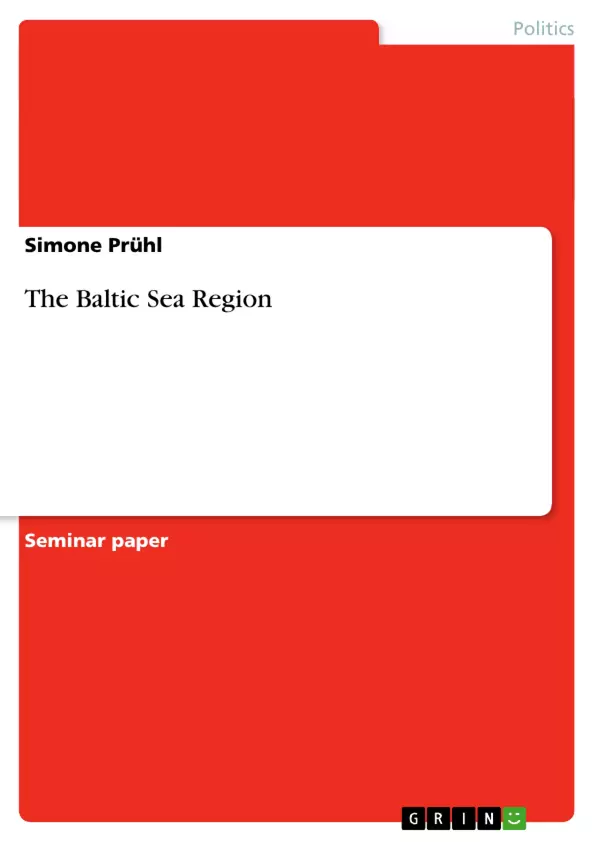In the contemporary debate about regions, the Baltic Sea Region is one of the most frequently used topics. The objective of this paper is to prove that, regardless of formal speeches and co-operation in many fields, the BSR is not a natural region, but only an artificial construct according to the interests of some politicians. To work this out, I am introducing important concepts for the theory of regionalism (inside-out, outside-in and region-building approach) and apply them on the case of the Baltic Sea Region. One of the most incisive events of International Politics was the end of the Cold War in 1989. Especially in terms of the development of regions, it was a crucial event giving „(...) new actuality to the study of regions and regionalism“ (Neumann 1992, p. 3). With the fall of the Iron Curtain, regional integration received fresh impulses and is now one of the most dynamic and current processes in contemporary Europe. All over the continent regions emerge and are the object of discussion. An area of special interest in studies of regionalism is the northern part of Europe, where momentarily – for example with the Baltic Sea Region – an interesting and active process of region-forming is taking place. [...]
Inhaltsverzeichnis (Table of Contents)
- Introduction
- The Baltic Sea Region - some general facts
- Work and self-perception of the BSR
- International Behaviour towards the BSR
- Theoretical background
- The classical approaches
- The inside-out approach
- The outside-in approach
- The region-building approach
- Applied approaches
- The BSR in terms of the inside-out approach
- The BSR in terms of the outside-in approach
- The BSR in terms of the region-building approach
- Conclusions
- References
Zielsetzung und Themenschwerpunkte (Objectives and Key Themes)
This paper aims to demonstrate that despite formal speeches and cooperation in various fields, the Baltic Sea Region (BSR) is not a natural region, but rather an artificial construct shaped by the interests of certain politicians. To accomplish this, the author introduces key concepts from regionalism theory, namely the inside-out, outside-in, and region-building approaches, and applies them to the case of the BSR.
- The concept of regionalism and the debate surrounding the definition of a "region"
- The role of political interests in shaping regional formations
- The application of various theoretical approaches to understand regional dynamics
- The case study of the Baltic Sea Region and its status as a "real" region
- The impact of international actors on the BSR's development
Zusammenfassung der Kapitel (Chapter Summaries)
- Introduction: The paper introduces the context of the Baltic Sea Region (BSR) in the post-Cold War era, highlighting the renewed interest in regionalism and integration within Europe. The author argues that despite widespread cooperation and recognition, the BSR's status as a "real" region is subject to scrutiny and analysis.
- The Baltic Sea Region - some general facts: This chapter provides an overview of the BSR, focusing on its historical context, the emergence of cooperation initiatives, and the role of institutions such as the Council of the Baltic Sea States (CBSS) in promoting regional collaboration. The chapter also explores the self-perception of the BSR as a unified entity and its engagement with international actors.
- Theoretical Background: This section delves into the theoretical underpinnings of regionalism, introducing the three key approaches: the inside-out approach, the outside-in approach, and the region-building approach. These approaches provide a framework for analyzing the formation and development of regions.
- Applied Approaches: This chapter applies the theoretical frameworks established in the previous section to the case of the BSR. It examines the region through the lens of the inside-out approach, the outside-in approach, and the region-building approach, analyzing the specific criteria of each approach and their relevance to the BSR.
Schlüsselwörter (Keywords)
The paper focuses on key terms like regionalism, Baltic Sea Region (BSR), inside-out approach, outside-in approach, region-building approach, cooperation, conflict, and artificial construct. The research examines the formation of the BSR, the role of political interests, and the theoretical frameworks that can be applied to understand regional dynamics in Europe. The paper also explores the perspectives of different international actors, such as the EU and the United States, on the BSR.
- Quote paper
- Simone Prühl (Author), 2003, The Baltic Sea Region, Munich, GRIN Verlag, https://www.grin.com/document/38534



